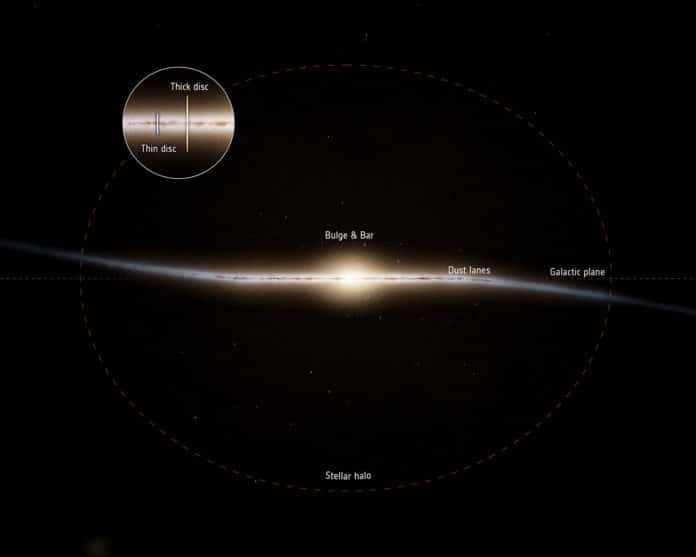Using data from ESA’s Gaia mission, astronomers have shown that a part of the Milky Way known as the ‘thick disc’ began forming 13 billion years ago, around 2 billion years earlier than expected, and just 0.8 billion years after the Big Bang.
They concluded after considering the brightness and positional data from Gaia’s Early Data Release 3 (EDR3) dataset. They combined it with measurements of the stars’ chemical compositions, as given by data from China’s Large Sky Area Multi-Object Fiber Spectroscopic Telescope (LAMOST) for roughly 250 000 stars to derive their ages.
Astronomers are mainly considered subgiant stars, where energy formation is stopped in the star’s core. The process has moved into a shell around the core. As a result, the star transformed itself into a giant red star.
The LAMOST data gives the metallicity. The brightness and metallicity allow astronomers to extract the star’s age from the computer models. Before Gaia, astronomers were routinely working with 20-40 percent uncertainties, which could result in the determined ages being imprecise by a billion years or more.
Maosheng Xiang from the Max-Planck Institute for Astronomy, Heidelberg, Germany, said, “With Gaia’s brightness data, we can determine the age of a subgiant star to a few percent.”
Milky Way comprises different components classified as the halo and the disc. The halo is considered the oldest component of the galaxy, whereas the thin disk contains most of the stars that we see as the misty band of light in the night sky that we call the Milky Way.
Scientists could build a timeline of the Milky Way’s formation by identifying subgiant stars in these different regions. And that’s when they got a surprise.
Scientists noted, “stellar ages revealed that the formation of the Milky Way falls into two different phases. In the first phase, which starts just 0.8 billion years after the Big Bang, the thick disc began forming stars. The inner parts of the halo may also have begun to come together at this stage, but the process rapidly accelerated to completion about two billion years later when a dwarf galaxy known as Gaia-Sausage-Enceladus merged with the Milky Way.”
“It filled the halo with stars and triggered the nascent thick disc to form the majority of its stars as clearly revealed by the new work. The thin disc of stars which holds the Sun was formed during the subsequent second phase of the galaxy’s formation.”
After the merger with Gaia-Sausage-Enceladus triggered the star-forming burst, the thick disc continued forming stars until the gas was used up at around 6 billion years after the Big Bang. During this, the metallicity of the thick disk increases by ten times.
However, scientists noticed a very tight stellar age—metallicity relation. This indicates that throughout that period, the gas-forming stars were well-mixed across the whole disk. The early Milky Way’s disk regions must have been formed from highly turbulent gas that effectively spread the metals far and wide.
Maosheng said, “Since the discovery of the ancient merger with Gaia-Sausage-Enceladus, in 2018, astronomers have suspected that the Milky Way was already there before the halo formed, but we didn’t have a clear picture of what that Milky Way looked like. Our results provide exquisite details about that part of the Milky Way, such as its birthday, star-formation rate, and metal enrichment history. Putting together these discoveries using Gaia data is revolutionizing our picture of when and how our galaxy was formed.”
Timo Prusti, Gaia Project Scientist for ESA, said, “With each new analysis and data release, Gaia allows us to piece together the history of our galaxy in even more unprecedented detail. With the release of Gaia DR3 in June, astronomers will be able to enrich the story with even more details.”
Journal Reference:
- Xiang, M., Rix, HW. A time-resolved picture of our Milky Way’s early formation history. Nature 603, 599–603 (2022). DOI: 10.1038/s41586-022-04496-5
